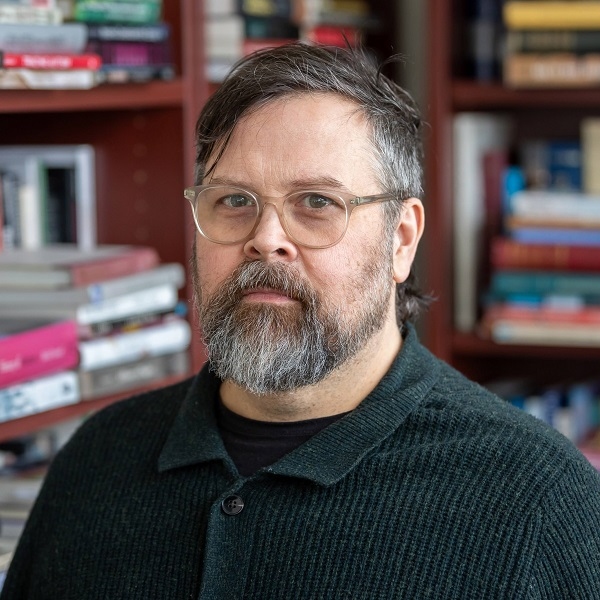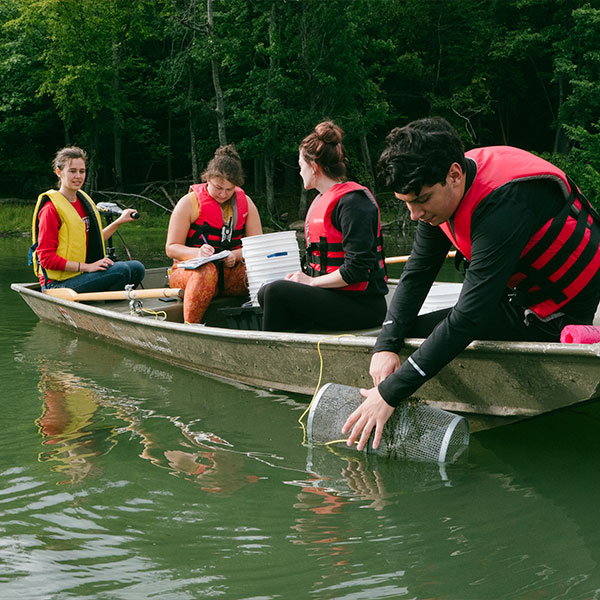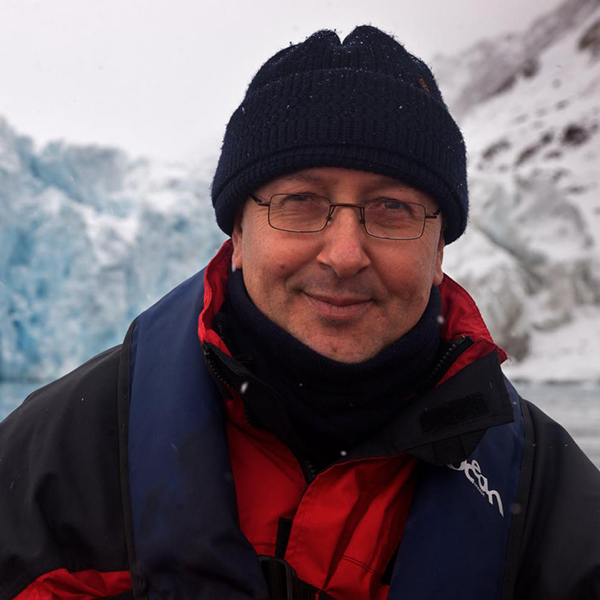Elena Bennett delights in uncertainty.
You can hear it in her voice, during a breakfast-time conversation about her attention-getting research on the unseen and unacknowledged relationships between humans and nature. An ecosystem ecologist jointly appointed to the Bieler School of Environment and the Department of Natural Resource Sciences, she’s up early and deep into a description of the data-gathering she’s doing for Canada’s Census of Environment, the first-ever national register of the country’s ecosystems and the services they provide.
Bennett is the principle investigator for NSERC ResNet, an interdisciplinary network of Canadian researchers and other specialists who examine the many different facets of our country’s ecosystems (she also chairs ResNet’s scientific committee). Along with her ResNet colleagues, she is busy developing new ways of understanding and assessing the present state and future possibilities of the country’s highly complex landscapes. She hopes to make useful contributions as Statistics Canada prepares the census (she was asked to join the external advisory committee for the census).
But as she homes in on a specific local problem of what should be done with Nova Scotia’s costly, vulnerable dikelands, which have long separated encroaching sea water from developed agricultural areas, she realizes she’s hit on an issue that both bothers her and excites her about the limitations of big-budget scientific research on the national scale.
“In helping to nudge Canada’s Census of Environment towards being as useful as possible to as many decision-makers as possible, one thing we’ve been thinking about is finding ways to engage actors at a very local level and assist their decisions even as we are also collecting national-scale data. How do we provide data that’s useful to federal and provincial decision-makers, but also useful in a very particular way to these local decision-makers?
“Scientifically I don’t think we know how to do that yet,” she adds, and now the measured, pensive delivery of McGill’s Canada Research Chair in Sustainability Science suddenly takes a passionate and intellectually impulsive turn. “And anywhere that I hear ‘We don’t know how to do that,’ I think, Oooh, that’s a neat idea.”
“Neat idea” may not be an official term in the research community’s lexicon, but it’s an uninhibited expression indicative of Bennett’s enthusiasm and lively sense of engagement – characteristics that have attracted an energized community of students to her lab that specializes in ecosystems services, the benefits people obtain from ecosystems.
There are simple, straightforward ways to measure the condition of ecosystems in order to understand how they are changing, based on easily definable categories of land use. But the premise of Bennett’s lab is that this traditional kind of statistical efficiency often misses the bigger, broader, more useful (if statistically messier) ecological story of what she calls “multifunctionality” – landscapes that aren’t just doing one easily defined thing. By adopting this more complex view of landscape, she believes, decision-makers can better build up the strength of ecosystems facing the shocks of an unpredictable future.
Separating landscapes into neatly defined categories may be a natural tendency – at least when the aim is to make agricultural areas as efficient and productive as possible, to feed the most people at the lowest cause within the smallest space, while avoiding the kind of trade-offs and tensions inevitable in a shared space. But that reduction in multifunctionality comes at a cost. “You’re so completely focused on getting more food,” says Bennett, “that you may get fewer other good things. And you may in the end even undercut your ability to produce food.”
She cites an issue that was her focus of study when she started at McGill as an assistant professor in 2005, the human impact of nutrients like phosphorus fertilizer: The drive to produce more food led to a greater application of the fertilizer, which damaged water quality, which then created huge problems for agriculture.
“We really undid ourselves with that one,” she says. “But now there’s talk about being ecologically or environmentally efficient, with the least impact on water quality. Now that’s an interesting question in my view, because trying to be efficient often undercuts the resilience of an ecosystem. Even though we’re being environmentally efficient and having fewer bad environmental outcomes, we’re still undermining the ecosystem by pushing it into a smaller and smaller window in which it can operate.”
By intending to do good, we may be doing harm. You could breed a crop to grow with less water, but then a flood or sudden rainstorm could be disastrous.
“The more constraining you do to a system,” says Bennett, “the less resilient those systems are to any shock other than the ones we’ve planned for. And we’re having more and more of those shocks all the time – sometimes they’re climate-oriented, or the economy tanks, or an agricultural pest comes in, or we think there’s going to be a drought and instead there’s a flood. We’re not good at foreseeing the future.”
From the big-picture perspective of Statistics Canada, it’s easier and simpler to conduct an environmental census on the model of a population census, with established categories that allow trends to be measured over time.
“But it misses things,” she says, “You can look at forests and think mostly about carbon. But what else is that landscape doing? A forest is storing carbon but it’s also providing opportunities for recreation, or a habitat for other species, and the same with an agricultural field: It’s a place that’s producing food, but it’s also providing aesthetic beauty, and a place where people live.
“When you start with the idea of an agricultural landscape, this already puts you in mind of food. What if we started with the idea that this is a landscape where people and nature are interacting in ways that should provide a beneficial relationship for both people and nature? When that’s your starting point, it’s quite a radical idea to move forward from there towards how we should be as stewards of the land.”
Human impact on the environment, especially in times of crisis, is frequently seen in stark us-and-them terms. Bennett’s vision, encapsulated in the idea of multifunctional landscapes, is to break down the boundaries and show that people are rooted in their landscapes – in an intimate relationship that can prompt them to be an active force for good in a necessarily transforming world.
“In environmental science, there are two typical kinds of narratives,” she says. “One, that people are evil, they’re the worst thing that ever happened to this planet, and we just need to get rid of them or constrain them somehow, and everything will then be okay. And then you have the other narrative, that people are technological geniuses and our brains are going to get us out of this and save us with some new carbon-scrubbing technology or whatever.
“To me, while neither of those approaches are entirely false, they’re not entirely true either. There’s a middle ground where people form relationships to each other, and to a place, that maybe offers a better way forward.”
There’s a hopefulness in that statement that feels uncommon among those who study human impacts on the environment. “I think I am by nature a pretty hopeful person,” Bennett says. “Hopefulness is often viewed as a passive quality. But I don’t see it that way at all – I see hope as something that demands that we act to bring about the future we want. That’s the piece that’s exciting to me.”
There’s no question that Bennett’s message of scientifically engaged optimism (exemplified in the Seeds of the Good Anthropocene project she co-founded, a database of positive community-based environmental initiatives described as “realistic pathways for change”) has been received as a welcome antidote to despairing visions of global devastation.
Earlier this year, she was awarded a 2022 Guggenheim Fellowship, and was named to the U.S. National Academy of Sciences (one of only four McGill professors who can claim that honour). Other environmental scientists are paying close attention to her research. In 2021, she was named a Clarivate Web of Science Highly Cited Researcher, meaning that her peers frequently cite her work.
She was also recently one of 10 scientists chosen to study the art and craft of storytelling at the University of Southern California’s Wrigley Storymakers program. The initiative, which involves teachers like The Atlantic‘s Pulitzer Prize-winning science writer Ed Yong, hopes to equip researchers with the training to tell their own stories.
“I have this germ of an idea about place and rootedness and how people can be a force for good in the world, especially in the world of environmental science,” says Bennett.
“I write like a scientist,” she adds with a laugh. “I tend to bury the lede and put the interesting stuff at the end.”


